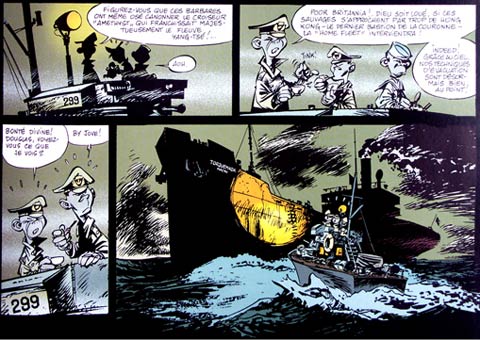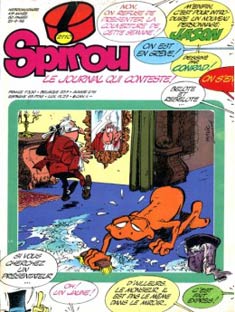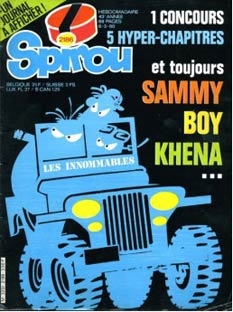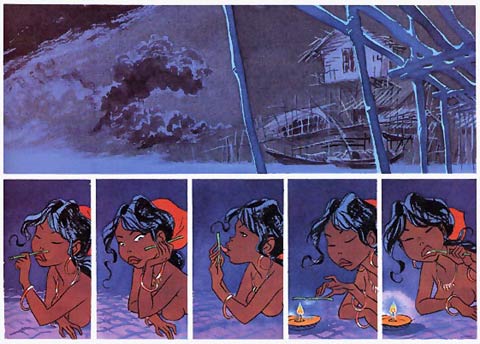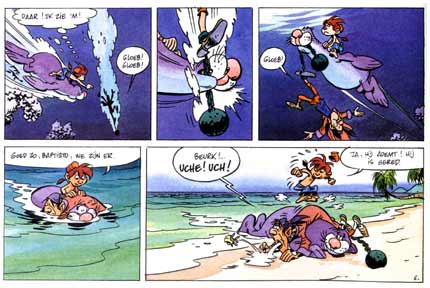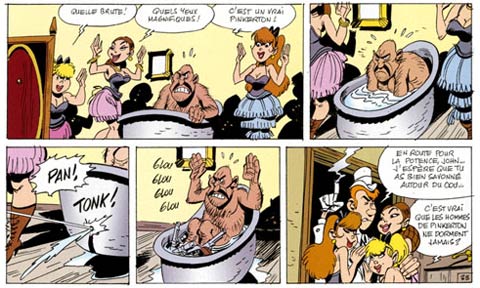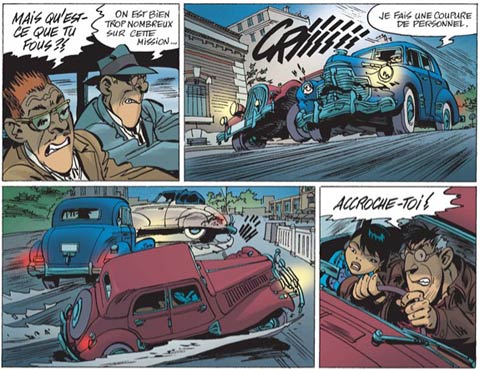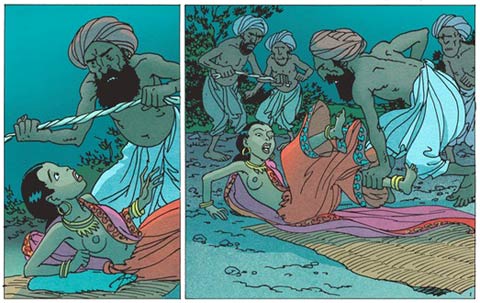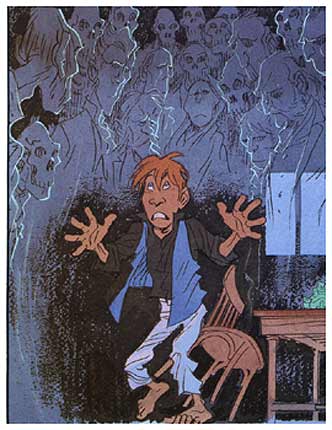'Les Innommables'.
Didier Conrad was born in Marseille into a family of Swiss origins. At the age of 14, published his first comic in the "Carte Blanche" section of Spirou magazine in 1973. Five years later, he drew the fantastic series 'Jason' with scripts by Jean-Claude Smit le Bénédicte (Mythic) for this same magazine. Around that time, he began a longime collaboration with Yann, also a young artist/writer from Marseille. The two rebellious artists filled the tops of the pages of Spirou magazine with their satirical drawings, in which the ridiculed the classic series of the magazine (collected in the small book '8 Mois dans l'Enfer des Hauts de Pages'), and they also made the poetic story 'Bébert le Cancrelat'.
Cover illustrations for Spirou.
In 1980, Yann and Conrad created their first long series, 'Les Innomables'. The first episode, 'Matricule triple zéro', was written by Conrad and drawn by Yann, but they switched duties from the second story, and a legendary series was born. With their controversial comic, Conrad and Yann created a small "revolution" within Spirou, because the cynical and violent comic didn't fit in with the "cheerful atmosphere" of the magazine. After three long stories, the comic was expelled from the magazine in 1983.
'Bob Marone'.
The duo then transferred from Dupuis to Glénat, where they created 'Bob Marone' for Circus magazine in 1983. This humorous comic was a parody of the famous 'Bob Morane' character of Henri Vernes, a series illustrated by Dino Attanasio, Gérald Forton, William Vance, Coria and Dimitri Armand over the years. But during the second story, Conrad and Yann split up after a disagreement and the script was finished by Lucie Commenge.
'Le Piège Malais'.
Conrad continued to work with Commenge, and created 'L'Avatar', the first story starring the character 'Ernest Poildu', in 1985. This comic was a prelude to the diptych 'Le Piège Malais', that appeared in the Aire Libre collection of the publishing house Dupuis in 1990. By this time, Conrad's style started to evolve from influence of Franquin, who had been his main inspiration up to that point, to Morris. In 1987-1988, the publishing company Brain Factory International released a four-volume comic book series where Franco-Belgian comic authors visualized several songs by singer Jacques Brel in comic strip form. The second volume, 'Les Prénoms' (1987) featured a contribution by Conrad.
'Donito'.
In 1991, Conrad returned to Spirou, where he began the children's series 'Donito' in 1991. In 1994, he resumed his collaboration with Yann again, and they revived the 'Innomables', this time at Dargaud. Between 1996 and 2004, they created their most classic stories with the characters in three cycles, situated in Hong-Kong, Korea and the USA.
'Cotton Kid'.
In addition, Yann & Conrad took on the joint pseudonym Pearce and made two books of the 'Lucky Luke' spin-off 'Kid Lucky', together with co-scriptwriter Jean Léturgie, from 1997. Afterwards, they continued their collaboration with another comical western series, 'Cotton Kid' between 1999 and 2003.
'Tigresse Blanche'.
Conrad settled in the USA in 1996, where he was employed by DreamWorks to work on the animated film 'The Road to El Dorado', while still working on 'Les Innomables' and 'Kid Lucky'. Between 2003 and 2005, Conrad and Yann revived 'Bob Marone' in Fluide Glacial, with art by Yoann.
'RAJ'.
In 2005, Conrad and Yann also started a spin-off to 'Les Innomables', called 'Tigresse Blanche'. Sophie Commenge (Wilbur) took over the scriptwork from Yann from the third story. Conrad and Commenge launched 'RAJ', a series set in colonial British India, in 2007. In 2011 and 2013, Conrad and Wilbur made two books of 'Marsu Kids', a spin-off to the 'Marsupilami' series by Marsu Productions. In October 2012, it was announced that Didier Conrad would succeed Albert Uderzo as the artist of 'Astérix'. Conrad's first book in the series, 'Astérix chez les Pictes', was written by Jean-Yves Ferri and published in October 2013.
Conrad was one of several artists to make a graphic contribution to 'Baston Labaffe no. 5: La Ballade des Baffes’ (Goupil, 1983), an official collective parody comic of André Franquin’s 'Gaston Lagaffe’. In 1990, he and Yann paid graphic tribute to François Walthéry in the collective homage book 'Natacha. Special 20 Ans' (Marsu Productions, 1990), which celebrated the 20th anniversary of Walthéry's series 'Natacha'. He paid tribute to Nikita Mandryka in the collective comic book 'Tronches de Concombre' (Dupuis, 1995).
Yann & Conrad were a strong influence on Robbert Damen, Jeroen De Coninck, Remco Polman and Zep. They also received strong admiration from veteran artist Daniel Kox.
Didier Conrad should not be confused with Didier Convard.
'Le Piège Malais'.
Didier Conrad intro
(en Français)



